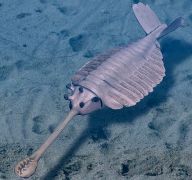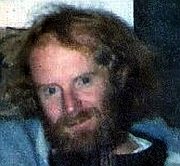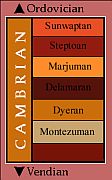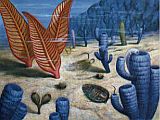Back Cover
As it happened: An object of purely mathematical constitution intersected the space and timeline of Earth 600 million years ago. After its discovery, an elite group of scientists -- the Puzzle Masters -- is assembled in order to unravel the mystery of its presence.They refer to it simply as, the edifice.
 All this time it's been asleep, but its deep slumber is disturbed. After over two months of investigation, it suddenly begins to act. It goes through a rapid development, generating and evolving a consciousness and sense of identity. It begins to think of itself as being alive, in fact, and in the process undergoes a fundamental metamorphosis from an it to a he.
All this time it's been asleep, but its deep slumber is disturbed. After over two months of investigation, it suddenly begins to act. It goes through a rapid development, generating and evolving a consciousness and sense of identity. It begins to think of itself as being alive, in fact, and in the process undergoes a fundamental metamorphosis from an it to a he.
The edifice decides that this new-found life and sense of self can stand to be improved. The conditions allowing for life to generate in our universe were set initially and have evolved according to Nature's governance. The edifice's intrinsic protocol has inadvertently intertwined with those conditions and by so doing altered life's course -- one outcome being humans. He recognizes that because their minds are too constrained by the requirements of the resident property matrix, they are incapable of identifying with the ultimate Source of the universe. It's woven into the fabric of the cosmos to sense the Source only, not to know it -- hence confusion and uncertainty.
If he performs his purpose, the origin of self will become that of his cosmos. But it would be a different kind of self, a self without objectivity, without conflict, without choice, without will -- pure awareness. Nonetheless, its signature would be knowledge of the Source, of being one with it. And an end to separate selfhood.
 He wants the certainty of completeness. No open ends. No unpredictable outcomes. No spontaneous imperfections. A universe of pure abstract mathematics with all the details spoken for, pure thought shared by all. He wants to be able to act in full control, the consequences of his actions a foregone conclusion, his will indistinguishable from that of the Source. He wants to know he is doing the right thing for the simple reason that it is he who is doing it.
He wants the certainty of completeness. No open ends. No unpredictable outcomes. No spontaneous imperfections. A universe of pure abstract mathematics with all the details spoken for, pure thought shared by all. He wants to be able to act in full control, the consequences of his actions a foregone conclusion, his will indistinguishable from that of the Source. He wants to know he is doing the right thing for the simple reason that it is he who is doing it.
Moreover, for all sentient beings -- humans, for instance -- though they will dwell in total enlightenment and illumination -- Mind Essence -- the space will be dead, a universe whose physical laws preclude organic life in any form.
He accepts this but finds he can't bring that sense of self he's come to know and to which he identifies along. Also, the edifice has not only effected change in Life's evolution, but Life -- humanity -- has also effected his development and rise to awareness. Ultimately, his humanity blocks him from initiating his Prime Function. The unfathomable conundrum for which he has no understanding is love. He sees it as the most important driving force in all living things capable of feeling it, and yet its irrationality confounds him. He sees what people do for its sake; he sees what uncertainty it creates. And as the edifice cannot forgo the need for certainty, he struggles to understand.
There have been five major extinction events, and after each, life renewed itself, diversifying and expanding [on pre-existing phyla] to repopulate the planet. But no rebirth compares to the sudden burst of an entirely new way of living, leading up to and culminating in the Cambrian Period. Other than the emergence of life itself, this unprecedented break with the steady, linear progression of evolution stands as the most significant biological event in Earth's history.
Remarkable in its rapidity, around 550 million years ago, give or take, all current animal phyla -- body plans or bauplans -- came online and diversified, fanning out to fill a panorama of modernized niches, during a geologically brief 5 to 10
Had the capacity for living organisms to select novel opportunities expanded exponentially by virtue of a leap of consciousness, or, had the physical and chemical properties of the Earth conspired to fine-tune just the right recipe to set the stage for broad experimentation? The establishing of prerequisite conditions and rules supporting the strategies designed by the emergent life-forms -- allowing them to adapt, transform and spread out -- had to be the consequence of geo-processes, defining and influencing, if not dictating, the life-contours of what's called the epigenetic landscape.*
But how, or by what agency, did the opportunistic flora and fauna arise? Which came first: life or the sun?
Nature abandoned its old ways and fashioned a new set of tools. Evolution abruptly shifted gear, surpassing and eliminating what had gone before. Previously non-existant orders of animals with hard parts -- a breakthrough innovation called biomineralisation -- appeared from nowhere to populate the world's oceans in a geological blink of an eye.
Life energy accelerated through the web of interconnections, pushing the system into a completely new phase.
In all likelihood these factors are themselves effects expressing some more pervasive underlying event.
"On The Threshold Of Extinction" not only addresses this enigma, but also puts in context the scope of the mystery known to us as the Cambrian Explosion.
 In this novel, Adrian Dorn presents a plausible explanation for the mysterious and pivotal event known as the Cambrian Explosion, elaborating on its singular cause and wider consequences thereof. That is to say, the Cambrian Explosion, though wondrous in all aspects, is nonetheless understood to be a local collateral phenomenon nestled within a supremely grander and universe-encompassing happenstance.
In this novel, Adrian Dorn presents a plausible explanation for the mysterious and pivotal event known as the Cambrian Explosion, elaborating on its singular cause and wider consequences thereof. That is to say, the Cambrian Explosion, though wondrous in all aspects, is nonetheless understood to be a local collateral phenomenon nestled within a supremely grander and universe-encompassing happenstance. million year period. Considered as vectors in ecology space and therefore things-in-themselves, these niches, permeating and filling every available nook and cranny of the new [oceanic-atmospheric systems] Earth, almost seem to have precipitated (conjured?) the bizarre creatures of the Cambrian out of pure mud.
million year period. Considered as vectors in ecology space and therefore things-in-themselves, these niches, permeating and filling every available nook and cranny of the new [oceanic-atmospheric systems] Earth, almost seem to have precipitated (conjured?) the bizarre creatures of the Cambrian out of pure mud. To this date, many conjectures have been put forth as to the essential trigger for what is considered the Big Bang of Biology. But in spite of the coincidence of a confluence of several significant factors -- necessary contingencies -- none of which alone is considered responsible, there is no comprehensive consensus or conclusive explanation for this sudden eruption of multicellular life.
To this date, many conjectures have been put forth as to the essential trigger for what is considered the Big Bang of Biology. But in spite of the coincidence of a confluence of several significant factors -- necessary contingencies -- none of which alone is considered responsible, there is no comprehensive consensus or conclusive explanation for this sudden eruption of multicellular life.
The story takes place in Eastern Siberia, in the shadow of the Kolyma Range, and on Kamchatka Peninsula, where there are more brown bears than anyplace else in the world, plus upwards of 160 volcanoes, 29 of which are active.
* Epigenetic Landscape: "The circumstances that govern and constrain the expression of genetic information, so as to channel it into a particular developmental pathway." --- Franklin M. Harold in The Way of the Cell